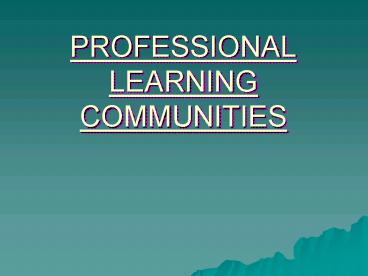PROFESSIONAL LEARNING COMMUNITIES - PowerPoint PPT Presentation
1 / 17
Title:
PROFESSIONAL LEARNING COMMUNITIES
Description:
Critical Outcomes. Definition: What do we want the student to know, ... CRITICAL ... Critical Outcome Model. Professional Learning Communities ... – PowerPoint PPT presentation
Number of Views:621
Avg rating:3.0/5.0
Title: PROFESSIONAL LEARNING COMMUNITIES
1
PROFESSIONAL LEARNING COMMUNITIES
2
Introduction To Professional Learning Communities
- The Prairie Spirit Model
3
Fundamental Assumptions
- We can make a difference our schools can be more
effective. - People improvement is the key to school
improvement. - Significant school improvement will impact
teaching and learning.
4
Need for a Collaborative Culture
- Improving schools require collaborative cultures
Without collaborative skills and relationships,
it is not possible to learn and to continue to
learn as much as you need to know to improve. - - Michael Fullan
5
Structural change that is not supported by
cultural change will eventually be overwhelmed by
the culture, and it is in the culture that any
organization finds meaning and stability. - Phil
Schlechty (1997, p. 136)
6
The Big Ideas that Should Drive Your PLC Efforts
- We accept learning as the fundamental purpose of
our school and therefore are willing to examine
all practices in light of their impact on
learning. - We are committed to working together to achieve
our collective purpose. We cultivate a
collaborative culture through development of high
performing teams. - We assess our effectiveness on the basis of
results rather than intentions. Individuals,
teams, and schools seek relevant data and
information and use that information to promote
continuous improvement.
LEARNING CULTURE TEAMS RESULTS
7
What are Professional Learning Communities ?
- A collaborative decision-making approach where
educators focus on how to improve student
learning.
8
Characteristics of a Learning Community
- Shared mission, vision values
- Collaborative teams
- Collective inquiry
- Action orientation/experimentation
- Commitment to continuous improvement
- Results orientation
9
Key Questions
- What do we expect students to learn?
- How will we know when they have learned it?
- How will we respond when they dont learn?
10
Critical Outcomes
- Definition What do we want the student to know,
understand or be able to do? - Endurance Is this learning enduring for the
student? - Leverage Will this learning support other
learnings for the student? - Readiness Does it support the next level of
learning?
11
CRITICAL OUTCOME FORMATS
- Demonstrate by using manipulatives and pictures
the concept of fractions as part of a shape or
solid. - The student will be able to read critically and
purposefully for meaning in a variety of media. - The student will recognize anger triggers and
utilize a skill set to engage in emotional
regulation. - The student will have a beginning, middle, and
end when writing a story. - I will understand and apply ratios, proportions
and percentages to solve real life problems and
applications.
12
Group Activity
13
Critical Outcome ModelProfessional Learning
Communities Learning Outcome Component
14
Critical Outcome ModelProfessional Learning
Communities Learning Outcome Component
15
If the purpose of school is truly to ensure high
levels of learning for all students, schools
will
- Clarify what each student is expected to learn.
- Monitor each students learning on a timely
basis. - Create systems to ensure students receive
additional time and support if they are not
learning. - Align all resources to support student learning.
- Examine all of the practices, policies, and
procedures of the school in light of their impact
on student learning.
16
Successful School Restructuring
- Characteristics of school that can link
restructuring initiatives with improved student
learning include the following - Focus on agreed vision of what student should
learn - Teaching that requires students to think, to
develop in-depth understanding, and to apply
academic learning to important, realistic
problems. - Schools that function as professional learning
communities in which teachers - 1. Are guided by a clear, commonly held, shared
purpose for student learning - 2. Feel a sense of collective responsibility for
student learning, and - 3. Collaborate with one another to promote
student learning - 4. Enjoy increased autonomy at the school site.
Newman and Wehlage, 1996
17
- Do not follow where the path may lead
- Go instead where there is no path and leave a
trail































